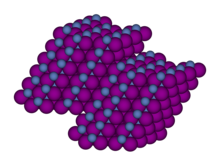Nickel(II) iodide
Appearance

| |

| |
| Names | |
|---|---|
| IUPAC name
Nickel(II) iodide
| |
| Other names
Nickelous iodide
| |
| Identifiers | |
3D model (
JSmol ) |
|
ECHA InfoCard
|
100.033.319 |
PubChem CID
|
|
| UNII | |
CompTox Dashboard (EPA)
|
|
| |
| |
| Properties | |
| I2Ni | |
| Molar mass | 312.5023 g·mol−1 |
| Appearance | iron-black solid (anhydrous) bluish-green solid (hexahydrate) |
| Density | 5.384 g/cm3 |
| Melting point | 780 °C (1,440 °F; 1,050 K) (anhydrous) 43 °C (hexahydrate, loses water) |
| 124.2 g/100 mL (0 °C) 188.2 g/100 mL (100 °C) | |
| Solubility | alcohols |
| +3875.0·10−6 cm3/mol | |
| Hazards | |
| NFPA 704 (fire diamond) | |
| Related compounds | |
Other anions
|
nickel(II) chloride, nickel(II) bromide, nickel(II) fluoride |
Other cations
|
copper iodide ,
|
Except where otherwise noted, data are given for materials in their standard state (at 25 °C [77 °F], 100 kPa).
| |
Nickel(II) iodide is an
aquo complex [Ni(H2O)6]I2 (image above).[2] This bluish-green colour is typical of hydrated nickel(II) compounds. Nickel iodides find some applications in homogeneous catalysis
.
Structure and synthesis
The anhydrous material crystallizes in the CdCl2 motif, featuring octahedral coordination geometry at each Ni(II) center. NiI2 is prepared by dehydration of the pentahydrate.[3]
NiI2 readily hydrates, and the hydrated form can be prepared by dissolution of nickel oxide, hydroxide, or carbonate in hydroiodic acid. The anhydrous form can be produced by treating powdered nickel with iodine.[4]
Applications in catalysis
NiI2 has some industrial applications as a
catalyst in carbonylation reactions.[5] It is also has niche uses as a reagent in organic synthesis, especially in conjunction with samarium(II) iodide.[6]
Like many nickel complexes, those derived from hydrated
nickel iodide have been used in cross coupling.[7]

References
- ISBN 0-8493-0486-5.
- .
- ISBN 9780470132449.
- )
- .
- ISBN 978-0471936237.
- PMID 20047282.

